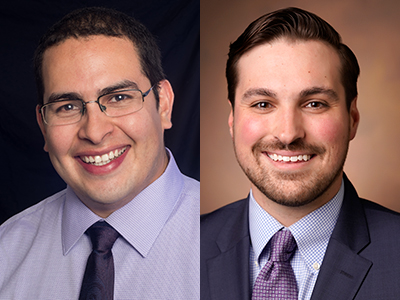 UAB Department of Neurosurgery Residents Dagoberto Estevez-Ordonez, M.D. (PGY-4) and Andrew T. Hale, M.D., Ph.D. (PGY-1) have been named abstract award winners by the American Association of Neurological Surgeons.
UAB Department of Neurosurgery Residents Dagoberto Estevez-Ordonez, M.D. (PGY-4) and Andrew T. Hale, M.D., Ph.D. (PGY-1) have been named abstract award winners by the American Association of Neurological Surgeons.
The educational program for the 2022 American Association of Neurological Surgeons (AANS) Annual Scientific Meeting includes the presentation of scientific data in general and subspecialty section sessions such as Oral Presentations and E-posters. Abstracts are peer-reviewed and scored on scientific merit, originality, and relevancy to the field of neurosurgery.
The AANS takes pride in promoting the highest quality of patient care and ranking among the top 5 NIH-funded neurosurgery departments in the nation.
This year, over 1,430 abstracts were submitted for presentation, and the award winners were carefully selected by the AANS Scientific Program Subcommittee. Estevez-Ordonez and Hale plan to present their findings at the 2022 AANS Annual Scientific Meeting in Philadephia on April 29. Learn more about their abstracts below:
Dagoberto Estevez-Ordonez, M.D.
-
Southeastern Brain Tumor Foundation Award
Abstract title: "Evaluation of immunologic parameters in canine glioma patients treated with an oncolytic herpes virus"
The goal was to molecularly characterize the tumor microenvironment (TME) and evaluate immunologic parameters in canine glioma patients before and after treatment with oncolytic human IL-12-expressing herpes simplex virus (M032).
They assessed 22 pet dogs with sporadically occurring gliomas that were enrolled in Stage 1 of an ongoing veterinary clinical trial to establish safety of intratumoral oncoviral therapy with M032, a genetically modified oncolytic herpes simplex virus (oHSV) between January 2018 and August 2020. Pre- and post-treatment specimens were evaluated with immunohistochemistry, NanoString, Luminex cytokine profiling and multi-parameter flow cytometry.
The findings indicated that M032 modulates the tumor-immune microenvironment in the canine glioma model, specifically effecting a shift from TH2 (IL-4) to TH1 (IFNγ) cytokine production within recirculating T cells after M032 treatment.
Andrew T. Hale, M.D., Ph.D.,
-
Kenneth Shulman Award
Abstract title: “Multi-omic analysis elucidates the genetic basis of hydrocephalus”
A PrediXcan analysis of hydrocephalus risk in ten neurological tissues and whole blood. Decreased expression of MAEL in the brain was significantly associated (Bonferroni-adjusted p < 0.05) with hydrocephalus. PrediXcan analysis of brain imaging and genomics data in the independent UK Biobank (N = 8,428) revealed that MAEL expression in the frontal cortex is associated with white matter and total brain volumes. Among the top differentially expressed genes in brain, a significant enrichment for gene-level associations with these structural phenotypes was observed, suggesting an effect on disease risk through regulation of brain structure and integrity. Additional support for these genes was identified through analysis of the choroid plexus transcriptome of a murine model of hydrocephalus. Finally, differential protein expression analysis in patient cerebrospinal fluid recapitulated disease-associated expression changes in neurological tissues, but not in whole blood. The findings provide convergent evidence highlighting the importance of tissue-specific pathways and mechanisms in the pathophysiology of hydrocephalus.
-
Cerebrovascular Section Best Clinical Scientific Paper
Abstract title: "Multi-national genome-wide association study and functional genomics analysis implicates decreased SIRT3 expression underlying intracranial aneurysm risk."
A multi-national GWAS across British, Finnish, and Japanese individuals in the UK Biobank, FinnGen, and Biobank Japan, respectively, and identified two previously unidentified intracranial (IA) risk loci. Functional genomics analysis of the most statistically-significant variant in our analysis within the SIRT3 locus suggests that decreased SIRT3 expression underlies IA risk. Given that activation of SIRT signaling has been shown to protect against cerebral ischemia and we identify decreased SIRT3 expression - at least in part - underlying IA risk, these findings may have direct translational relevance. Illuminating the genetic determinants of IA will provide insights into IA pathophysiology, treatment, and strategies for incorporating genetic data into routine clinical care.
Co-authors include Jing He (Vanderbilt University Medical Center) and Jesse Jones (UAB Departments of Neurosurgery and Radiology).